THE TURN:
Its notation, execution, and the challenges of historical interpretation

"Douglas who?"
Douglas Niedt is a successful concert and recording artist and highly respected master classical guitar teacher with 50 years of teaching experience. He is Associate Professor of Music (retired), at the Conservatory of Music and Dance, University of Missouri-Kansas City and a Fellow of the Henry W. Bloch School of Management—Regnier Institute for Entrepreneurship and Innovation.
Doug studied with such diverse masters as Andrés Segovia, Pepe Romero, Christopher Parkening, Narciso Yepes, Oscar Ghiglia, and Jorge Morel. Therefore, Doug provides solutions for you from a variety of perspectives and schools of thought.
He gives accurate, reliable advice that has been tested in performance on the concert stage that will work for you at home.
PURCHASE AN ALL-ACCESS PASS
TO THE VAULT OF CLASSICAL GUITAR TECHNIQUE TIPS
"Hello Mr Niedt,
My name's Gretchen, and I'm so happy I purchased an All-Access Pass to the Vault. I love your awesome technique tips. I'm amazed how much I have improved my playing.
Thank you!"
ARE YOU LOOKING FOR PROVEN STRATEGIES
THAT WILL MAKE YOU A BETTER GUITARIST?
Check out the game-changing tips in my Vault—I promise they will kick your playing up to the next level.
Purchase an All-Access Pass to the Vault.
It's a one-time purchase of only $36!
You receive full access to:
- Over 180 technique tips in The Vault.
- Special arrangements of Christmas music
- Arrangement of the beautiful Celtic song, Skellig
- Comprehensive guide, How to Master the Classical Guitar Tremolo
All that for a one-time payment of only $36. Take me to the page to Purchase an All-Access Pass
THE TURN:
Its notation, execution, and the challenges of historical interpretation
By Douglas Niedt
Copyright Douglas Niedt. All Rights Reserved.
This article may be reprinted, but please be considerate and give credit to Douglas Niedt.
PREFACE
The first thing you need to know when deciding how to play any ornament in pre-20th-century music is that there was no "common practice." The notation and execution of ornaments varied from country to country and composer to composer.
Written instructions from long ago or ornament tables (even by J.S. Bach) cannot overcome the general shortcomings of musical notation. Rigid rules, no matter where they come from, go against the very nature of ornaments—they were often improvised and, therefore, are too free to be tamed into regularity or taught by the book.
Descriptions of ornaments are only rough outlines, and many are contradictory. It's a jungle and very frustrating to try to figure out. There is simply no definitive solution to any ornament in a given situation. Therefore, be skeptical of everything I write from here on!
If you want a short answer to how to play an ornament, I say, "Do whatever you want. Do what makes the music sound best, and do what sounds best to you. In the end, that's what counts."
SUMMARY
The Standard Turn
A turn is a group of four sequential notes:
- An upper auxiliary note (one-half to a whole step above the principal note)
- The principal note
- A lower auxiliary note (one-half to a whole step below the principal note)
- The principal note again
Example: If C is the principal note, the turn would be D-C-B-C.
Notation:
- Standard turn is notated with a backward S-shape lying on its side, sometimes called an "inverted lazy S," above the staff.
The Inverted Turn
The inverted turn is a sequence of:
- A lower auxiliary note (one-half to a whole step below the principal note)
- The principal note
- An upper auxiliary note (one-half to a whole step above the principal note)
- The principal note again
Example: If C is the principal note, the inverted turn would be B-C-D-C.
Notation of the inverted turn
- The inverted turn uses the same symbol as the standard turn but with a short vertical line through the center.
The French Variant of the Turn
French composers before and around 1700 sometimes used the French Variant of the turn:
- The French Variant of the turn starts on the principal note
- Moves to a lower auxiliary note (one-half to a whole step below the principal note)
- Another lower auxiliary a third below the principal note
- Back to the lower auxiliary (one-half to a whole step below the principal note)
- Ends on the principal note
Example: If the principal note is C, the French variant would be C-B-A-B-C.
Notation for Turns
- Standard Turn Symbol: Backward S-shape lying on its side.
- Inverted Turn Symbol: Same as the standard turn but with a short vertical line through the center.
- Example: J.S. Bach's Table of Ornaments for his son uses these symbols in his keyboard music but notates turns in regular notes in other music.
Note values and rhythms
The note values for standard and inverted turns depend on:
- The passage's tempo
- The length of the principal note
- The surrounding notes
- The desired effect
Turns usually start on the beat.
Accidentals in Turns
How accidentals are used with turn symbols
- An accidental above the turn symbol applies to the upper auxiliary.
- An accidental below the turn symbol applies to the lower auxiliary.
- Note: Composers did not always adhere to this rule.
The Connective or Embedded Turn
Description: Connects the principal note to the following notes, beginning before a strong beat.
- Description: The connectgive of embedded turn connects the principal note to the following notes, beginning before a strong beat.
- Notation: Regular turn symbol between two notes or written out as small grace notes.
- Example: In Mozart’s Tema con Variazioni, a connective turn is written in small 32nd grace notes.
Performance of the connective or embedded turn
- Start the turn after playing the principal note, with the rhythm determined by the available time.
Examples of Turns in Guitar Music
Fernando Sor:
- Used all three systems of notation: symbols, grace notes, and regular notes.
- Example: Measure 2 of the theme to his Variations on a Theme by Mozart Op. 9 includes an inverted turn played before the main beat, written with grace notes.
Francisco Tárrega:
- Usually notated turns with grace notes.
- Example: Measure 2 of "¡Marieta!" includes an inverted turn with grace notes, starting before the strong beat.
This begins a comprehensive explanation of the turn
THERE ARE TWO BASIC TYPES OF TURNS (and a variant)
English: Turn; Italian: grupetto, groppo (or gruppo) ascendente or descendente; Bach: cadence; French: double cadence, double, doublé, brisée; German: doppelschlag.
The Standard Turn
A standard turn is a group of four sequential notes: an upper auxiliary note one-half to a whole step above the principal note, the principal note, a lower auxiliary note one-half to a whole step below the principal note, and finally, the principal note. If C is the principal note, the turn would be D-C-B-C. Example #1:

The Inverted Turn
There is also the inverted turn, a sequence of a lower auxiliary note one-half to a whole step below the principal note, the principal note, an upper auxiliary note one-half to a whole step above the principal note, and finally, the principal note. So, if C is the principal note, the inverted turn would be B-C-D-C. Example #2:

The French Variant of the Turn
Before and around 1700, a few French composers used a variant that started on the principal note, then a lower auxiliary note one-half to a whole step below the principal note, another lower auxiliary a third below the principal note, the lower auxiliary one-half to a whole step below the principal note, ending on the principal note. So, if the principal note is C, the French variant would be C-B-A-B-C. Example #3:

What is the Notation for a Standard Turn?
Composers notate a standard turn with a backward S-shape lying on its side, sometimes known as an "inverted lazy S," above the staff. Some composers, including J. S. Bach, occasionally wrote the symbol vertically instead of horizontally. Example #4:

In the Table of Ornaments ("Explanation of various signs, intimating the way of gracefully rendering certain ornaments") that J. S. Bach wrote out for his son Wilhelm Friederich, J. S. Bach calls the turn a cadence and uses the standard turn symbol. But he only used the symbol in his keyboard music. In the rest of his music, Bach notated turns in regular notes (rarely with small grace notes), not symbols.
What is the Notation for an Inverted Turn?
The inverted turn is the same symbol as the standard turn but with a short vertical line through the center: Example #5:

C. P. E. Bach introduced the upside-down turn symbol to notate an inverted turn, but not all later composers consistently differentiated between the two. Plus, at first glance, it is hard to see the difference between the two symbols. Example #6:

How Did Composers Notate Turns After the Baroque Period?
From the Baroque period onward, composers often notated their standard turns in regular notes or with small grace notes rather than using symbols as in this excerpt from Mozart’s Sonata in A. Example #7:

Post-Baroque composers also notated inverted turns with grace notes or regular-sized notes instead of symbols. Here is an example in the first measure of Mozart’s Rondo in A Minor K. 511. Example #8:
Both the Standard and Inverted Turns Start ON the Beat
Usually, the standard turn and inverted turn start ON the beat. The connective or embedded turn which we will look at soon, starts before the beat.
What are the note values and rhythms of a turn?
In the standard and inverted trills, the note values will vary according to the passage's tempo, the length of the principal note, what precedes and follows the turn, what is happening in the other voices, and the desired effect. Here are some possible note values for a standard turn (the same values apply to the inverted turn). Example #9:

Here are some simple examples of the standard turn. Example #10:
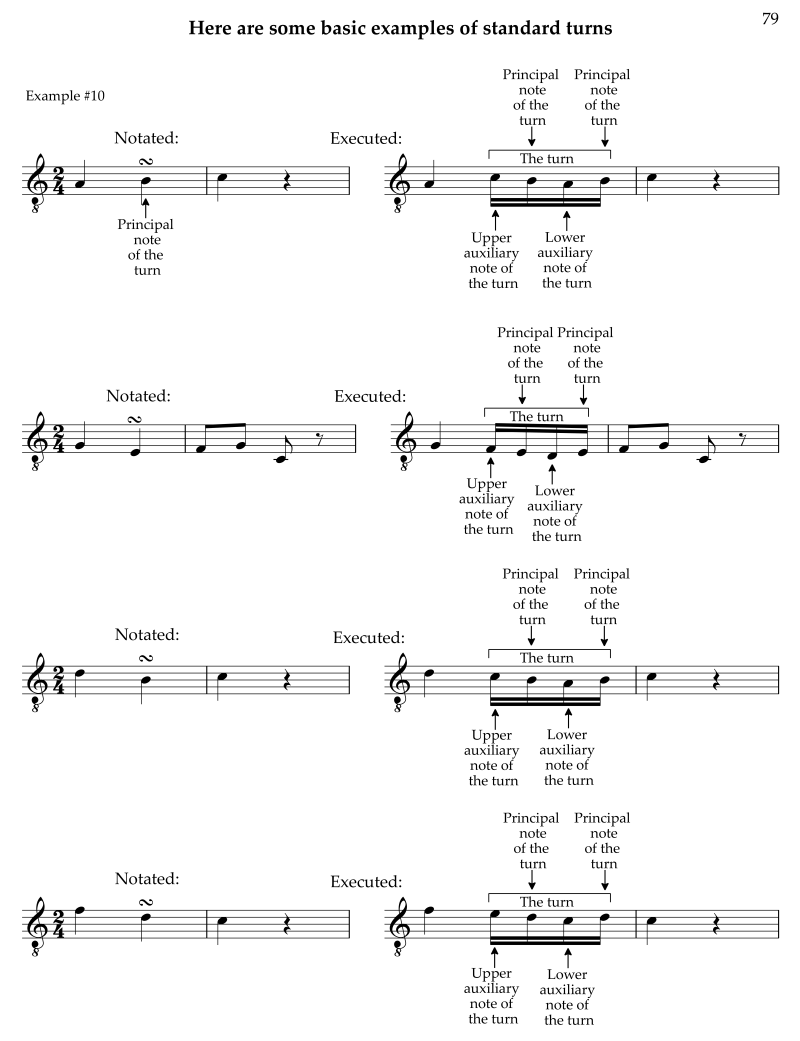
Are accidentals used with turns?
Yes, a composer may place a small accidental (sharp, flat, or natural) above or below the turn symbol. If the accidental is above the turn symbol, it applies to the upper auxiliary. If the accidental is below the turn, it applies to the lower auxiliary. However, composers did not always adhere to this rule. Occasionally, a composer will place an accidental above the turn symbol that applies to the lower auxiliary. Example #11:
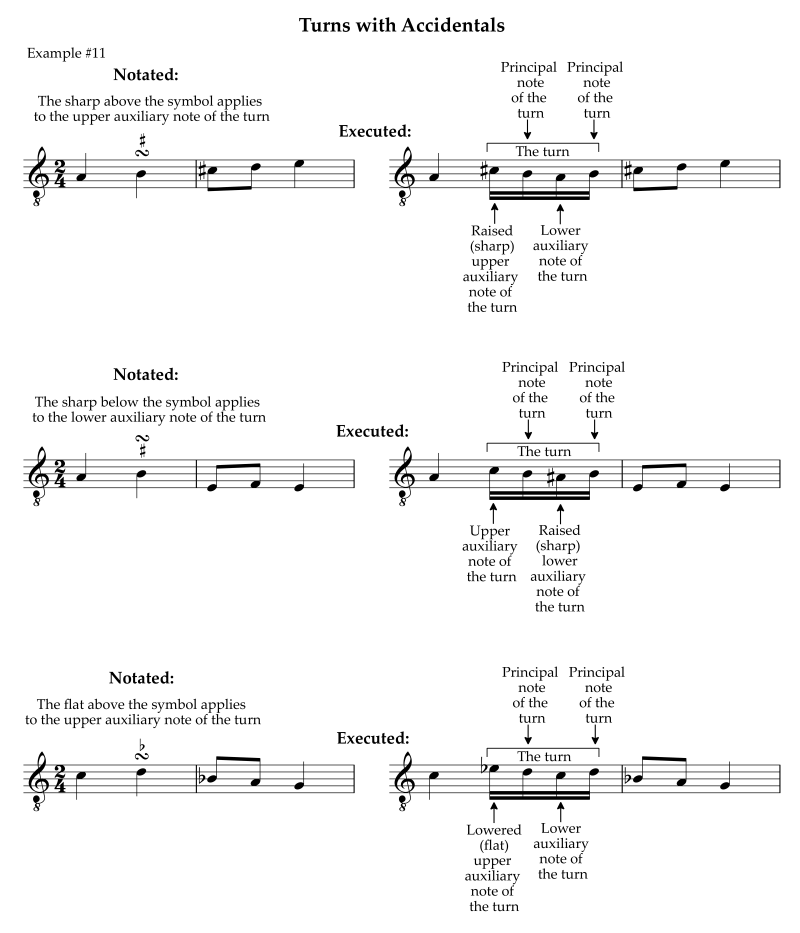
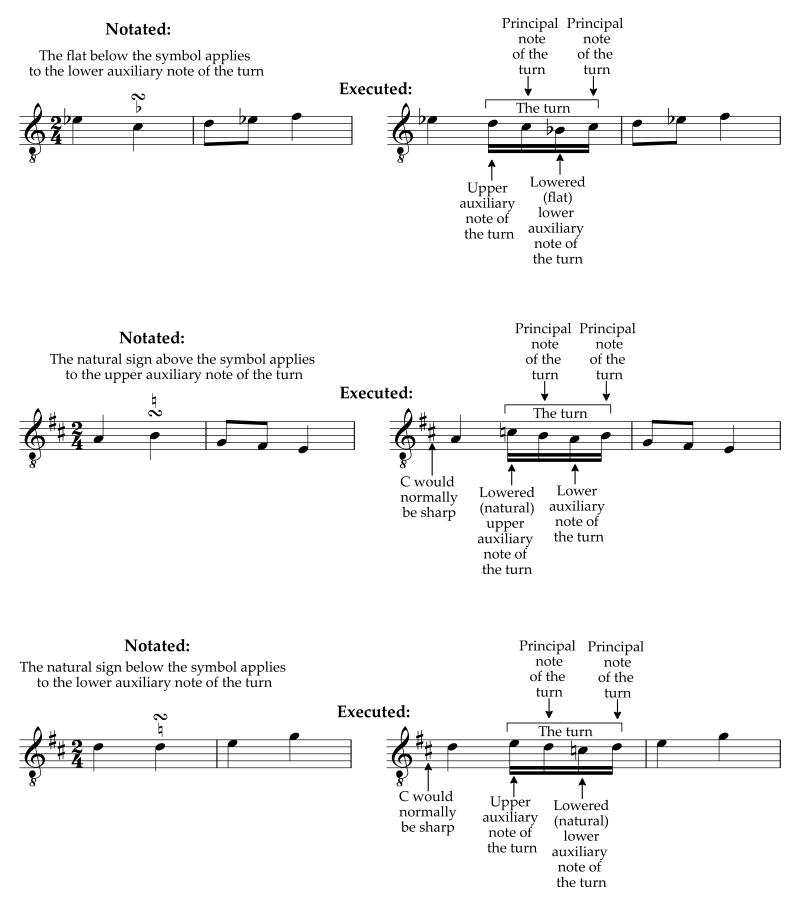
The Connective or Embedded Turn
There is a frequently-used class of turns that eminent scholar Frederick Neumann calls embedded or "connective" turns that begin BEFORE a strong beat. The connective or embedded turn literally connects the principal note to the notes that follow. The connective or embedded turn consists of the same notes as a standard turn. The difference is that composers notate this class of turn by placing the regular turn symbol BETWEEN TWO NOTES. Example #12:

Or, especially after the Baroque period, they wrote out the connective or embedded turn in small grace notes as in this example from Mozart’s Tema con Variazioni. Example #13:
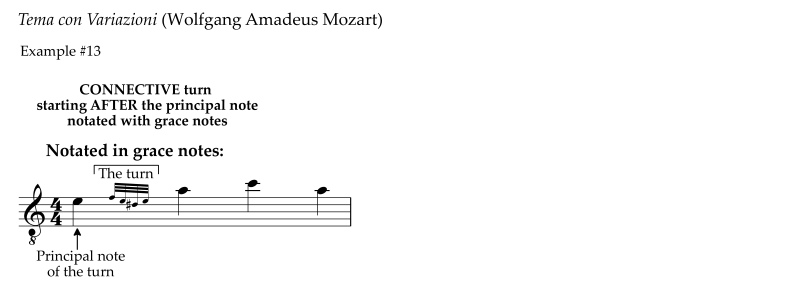
In the connective or embedded turn, the performer should start the turn after playing the principal note. The rhythm of the turn will be determined by the amount of time available for it. There are usually several acceptable solutions.
For example, in his Tema con Variazioni, Mozart writes a connective or embedded turn. Example #14:
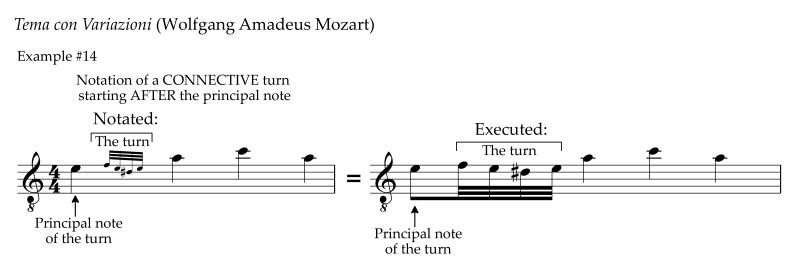
The melody is in four quarter notes. If we play it on the guitar, the first melody note is first-string open E, the second melody note is 1st-string A, the third melody note is 1st-string high C, and the final melody note is 1st-string A. Mozart writes the turn (F-E-D#-E) in small 32nd grace notes. To play this measure, we would play the first-string open E as an 8th note. Next, the connective turn would be F-E-D#-E in 32nd notes. Then, you would continue the melody, playing the second melody note A, the third melody note high C, and the final melody A as quarter notes.
Here are some additional examples. Example #15:
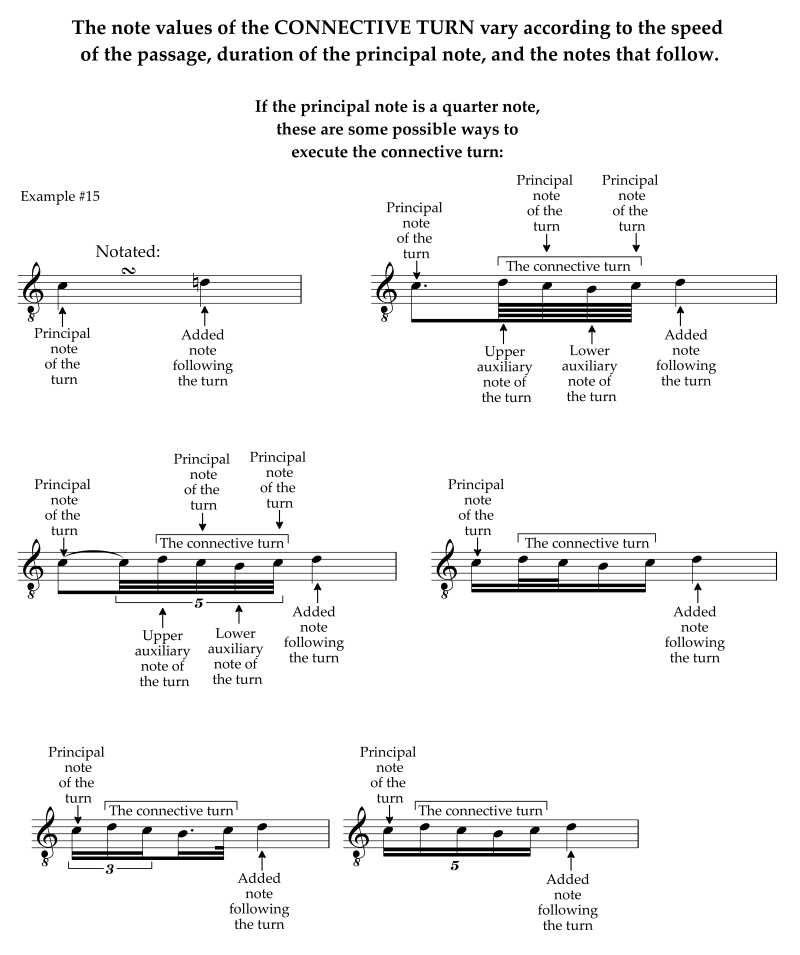
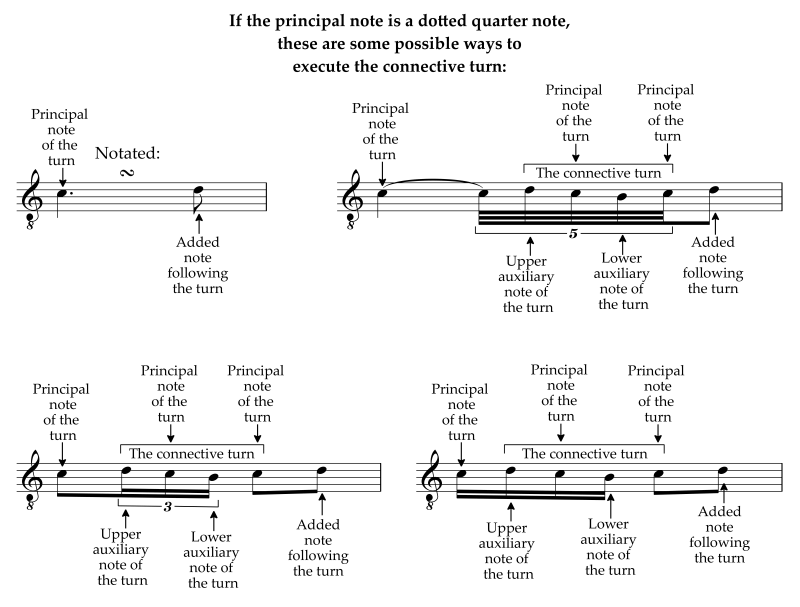
Examples of Turns in Guitar Music
Fernando Sor frequently used turns in his guitar music. He wrote them using all three systems of notation: symbols, as grace notes, and as regular notes. For example, in measure 2 of the theme to his Variations on a Theme by Mozart, Op. 9, Fernando Sor inserts an inverted turn played BEFORE the main beat, written with grace notes. Example #16:
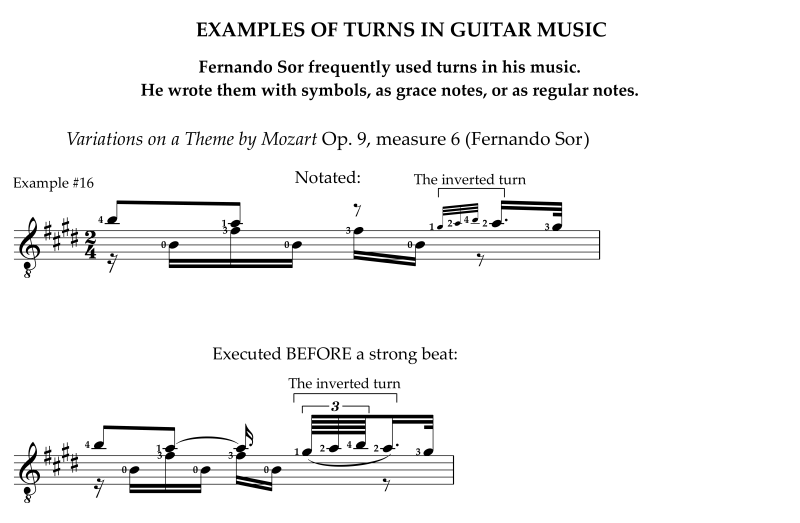
In measure 1 of his "Minuetto and Trio," from Grand Sonata No. 2, Sor notates a standard turn played ON the beat in regular notes. Example #17:

In measure 100 of his "Andante Largo" from Grand Sonata No. 2, Sor notates a turn played ON the beat as a symbol. Example #18:
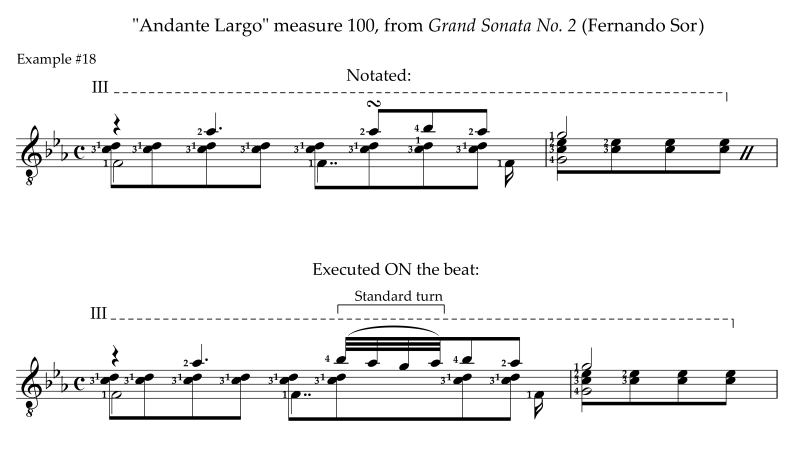
A more complex example occurs in measure 8 of the "Allegro" in his Grand Solo, Op. 14 (the Meissonnier edition), where he notates a turn with grace notes. However, the performer must synchronize the notes of the turn with the continuous bass notes underneath. I show two ways to execute it. Example #19:
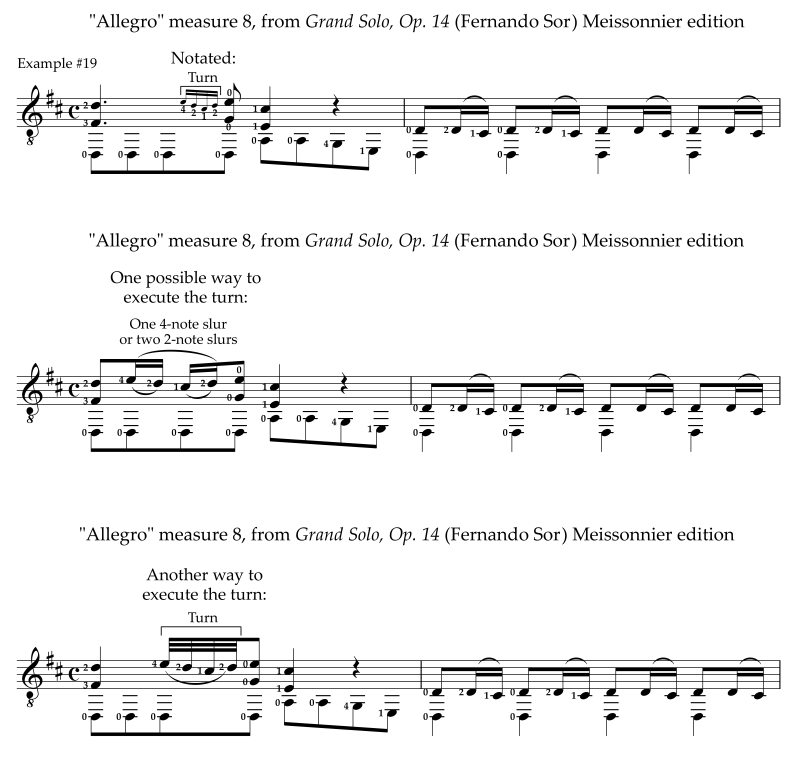
Francisco Tárrega also used turns in his guitar music. He usually notated them with grace notes.
In measure 2 of "¡Marieta!" Tárrega notates an inverted turn with grace notes. The turn starts BEFORE the strong beat. I show two ways to play it. Example #20:
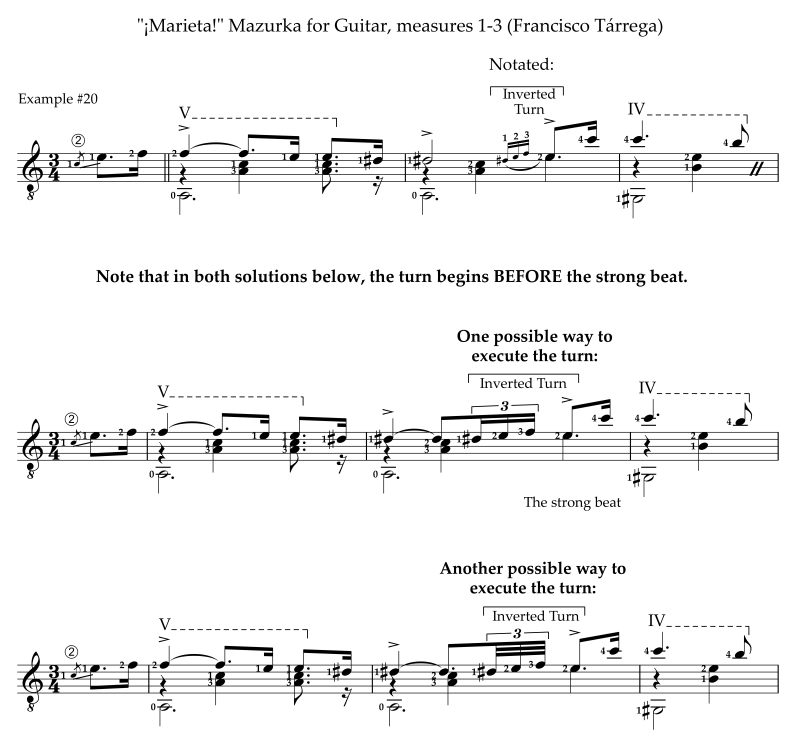
Further Reading
If you want to explore any of these topics in-depth (630 pages), I highly recommend one of my favorite books, Ornamentation in Baroque and Post-Baroque Music With Special Emphasis on J.S. Bach by Frederick Neumann.
Cross-String Ornaments
Turns (and many other ornaments) may be executed with slurs (hammer-ons and pull-offs) or as cross-string ornaments. For detailed information on cross-string ornaments, see the following:
Cross-String Ornaments Part 1
Cross-String Ornaments Part 2
Cross-String Ornaments Part 3
DOWNLOAD THE PDF
Download the PDF here: ORNAMENTS: THE TURN
